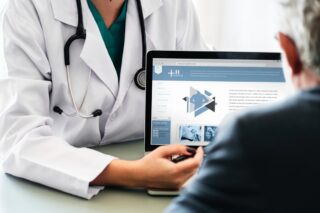Q Exchange
Teledermatology Service.
- Proposal
- 2019

Meet the team
Also:
- Dr Kazeem Salako
- Clare Atkins Project Manager
- Prof. Ali Al-Sherbaz
What is the challenge your project is going to address and how does it connect to your chosen theme?
The current challenge is long waiting times for Dermatology within the Trust as well as patients being referred to Consultant Dermatologists that could have been managed in the Community by the GP.
This service will give an alternative to GP’s in accessing Dermatology advice and support without the need to refer patients for appointments.
What does your project aim to achieve?
The project aims to address the waiting times for patient’s to access a Consultant Dermatologist. This will be by reducing the number of patient’s that require a face to face consultation. GP’s can speak to the Consultant through the system asking for advice etc. The Consultant can then advise on the most appropriate management plan for that patient. This may involve further treatment the GP can offer, or may require something prior to seeing the Consultant. If this is the case that treatment/biopsy/test can all be performed while waiting to be seen by the Consultant. This should stream line the treatment path for patients using the service. This would save clinic slots as patients were often seen by a Consultant then sent for a biopsy or test then see the Consultant again. It would also keep the management of some patients with their GP’s therefore reducing the number that would be seen by a Consultant. The GP’s would have advice and support though the system.
How will the project be delivered?
The team are working closely with the University of Northampton to develop the software. This has been developed in Conjunction with a Consultant Dermatologist to ensure the right clinical focus. We are also actively working with our colleagues in Primary Care to ensure the system is user friendly and aligned to their needs.
What and how is your project going to share learning throughout?
The project is being measured through various different ways including staff and patient satisfaction and the impact on the referral to treatment time to see a Consultant Dermatologist. There is two way communication between Primary Care and Northampton General to share learning as the project develops. Once the project has shown improved results we can share learning to the wider Q community.
How you can contribute
- One comment currently is trying to integrate this system with System One the GP's are using. We have added a section where a print out from System One can be uploaded to save completing the form entirely. The feedback we have received from the GP's is trying to fill out additional notes in their allocated patient time slot is difficult so if this can be integrated it would be easier for them. if anyone has any thoughts on this we would be grateful for feedback.
Plan timeline
| 31 Jul 2019 | Enrolled GP's to trial and test system |
|---|---|
| 30 Sep 2019 | Actively using system for patients in real time |
| 31 Dec 2019 | Recruit further GP's and Practices |
| 31 Jul 2020 | Be using system for majority of referrals |
Comments
Delia O'Rourke 22 Jul 2019
Who will take the picture? We have a local project which is similar to the one you describe. One where the image is taken in primary care ( the practice is paid to take the image with a dermatoscope and send it to the consultant for review) and the other by a medical photographer which requires the patient trekking to the hospital.
Clare Atkins 23 Jul 2019
Thank you for your question Delia. The GP's will take the photos in Primary Care as part of their Consultation. Consent will be obtained by them at the time and recorded on the system. There is no current plan for medical photography to be involved at this initial stage. The initial idea is that the photographs the GP's take along with the medical history will be sufficient to make the initial decision about whether to refer straight away or commence an alternative treatment in the mean time. This will not be used currently for anything that should be referred in as a 2 week wait.
Clare Atkins 16 Jul 2019
Hi Kathleen, part of the system includes diagnosis as the Consultant will make a decision based on the details and images provided. The idea would be that if a condition needed a biopsy for example, the biopsy could be arranged at the same time as the referral. This means the patient could have the biopsy while waiting to see the Consultant instead of following.
If the Consultant requires more information there can be a two way conversation through the system. So the Consultant might say watch and wait or manage the condition with this prescription etc.
If the images are of insufficient quality they can be requested to repeat through the system.
The system will not be for anyone needing a 2 week wait appointment.
Kathleen Reinoga 16 Jul 2019
Sounds great!
Kathleen Reinoga 16 Jul 2019
Would patient assessment include diagnosis? What methods would support accurate images of the patient's skin for the consultant to review?
Comments are now closed for this post.